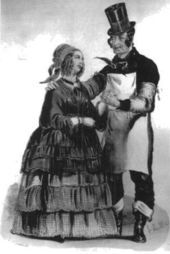
B'hoy and g'hal
Encyclopedia

Slang
Slang is the use of informal words and expressions that are not considered standard in the speaker's language or dialect but are considered more acceptable when used socially. Slang is often to be found in areas of the lexicon that refer to things considered taboo...
words used to describe the young men and women of the rough-and-tumble working class
Working class
Working class is a term used in the social sciences and in ordinary conversation to describe those employed in lower tier jobs , often extending to those in unemployment or otherwise possessing below-average incomes...
culture of Lower Manhattan
Lower Manhattan
Lower Manhattan is the southernmost part of the island of Manhattan, the main island and center of business and government of the City of New York...
in the late 1840s and into the period of the American Civil War
American Civil War
The American Civil War was a civil war fought in the United States of America. In response to the election of Abraham Lincoln as President of the United States, 11 southern slave states declared their secession from the United States and formed the Confederate States of America ; the other 25...
. They spoke a slang, with phrases such as "Hi-hi," "Lam him" and "Cheese it".
The prototypical artistic representation of a b'hoy came in 1848, when Frank Chanfrau
Frank Chanfrau
Francis "Frank" S. Chanfrau was an American actor and theatre manager in the 19th century. He began his career playing bit parts and doing impressions of star actors such as Edwin Forrest and of ethnic groups. In 1848, he appeared as a Bowery b'hoy named Mose in A Glance at New York...
played the character Mose the Fireboy
Mose the Fireboy
Mose the Fireboy was the pseudonym of an American folk hero and supposed leader of the Bowery Boys during the 1840s, possibly based on Mose Humphrey. One of its most celebrated leaders during the period, he and his lieutenant Syksey were well-known for battling members of the Dead Rabbits and...
in Benjamin A. Baker's A Glance at New York. Mose is a pugilistic Irish
Irish people
The Irish people are an ethnic group who originate in Ireland, an island in northwestern Europe. Ireland has been populated for around 9,000 years , with the Irish people's earliest ancestors recorded having legends of being descended from groups such as the Nemedians, Fomorians, Fir Bolg, Tuatha...
volunteer fireman. T. Allston Brown
T. Allston Brown
Thomas Allston Brown was an American theater critic, newspaper editor, talent agent and manager, and theater historian, best known for his History of the American Stage, published in 1872. Brown was born in Newburyport, Massachusetts...
gives this description: Details varied with each production; some b'hoys were named Sykesy or Syksey, others were butcher's apprentices. Haswell gives a slightly different description of the archetype: His girlfriend Lize was the prototypical g'hal, dressed in cheap finery and singing songs from her favorite minstrel show
Minstrel show
The minstrel show, or minstrelsy, was an American entertainment consisting of comic skits, variety acts, dancing, and music, performed by white people in blackface or, especially after the Civil War, black people in blackface....
s.
Mose plays became an enormous hit in New York and other large cities, and theatres were filled with b'hoys and g'hals clamoring to see Chanfrau and other actors performed Bowery b'hoy characters. William Northall even complained that at the Olympic Theatre
Olympic Theatre
The Olympic Theatre, sometimes known as the Royal Olympic Theatre, was a 19th-century London theatre, opened in 1806 and located at the junction of Drury Lane, Wych Street, and Newcastle Street. The theatre specialised in comedies throughout much of its existence...

